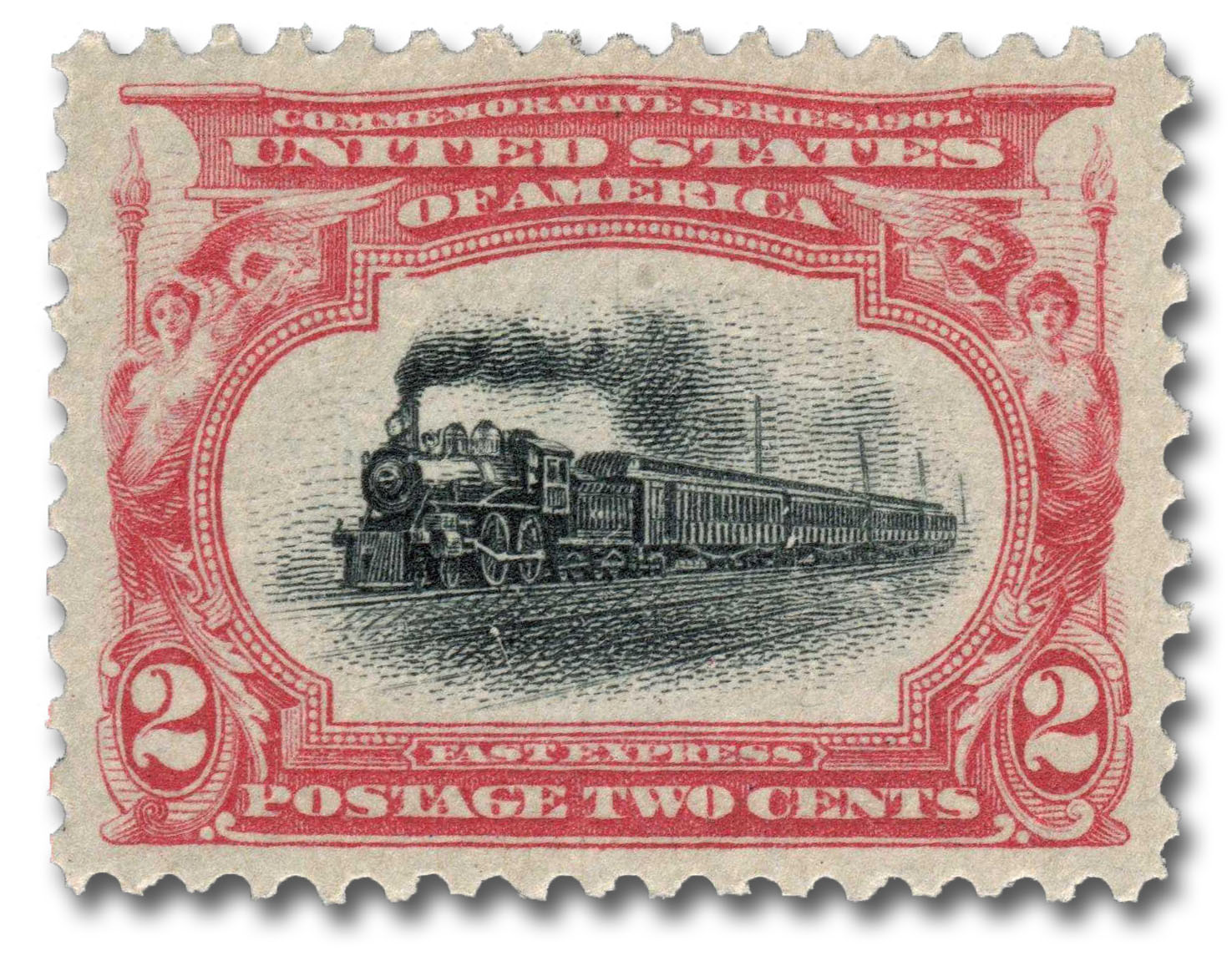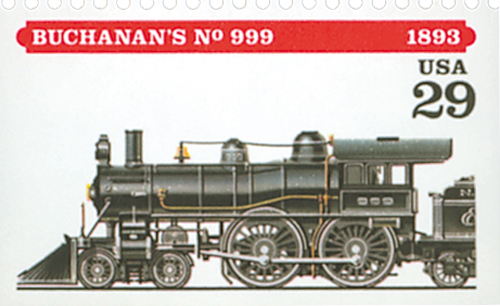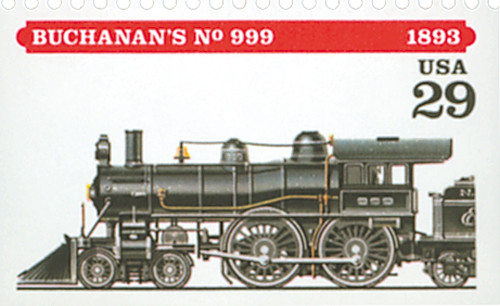
# 2847 - 1994 29c Locomotives: Buchanan's #999
US #2847
1994 Buchanan’s No. 999
- Part of set of five picturing American locomotives
- Similar in design to 1987 Locomotive stamps
Category of Stamp: Commemorative
Set: Locomotives
Value: 29¢, First-Class Mail rate
First Day of Issue: July 28, 1994
First Day City: Chama, New Mexico
Quantity Issued: 31,840,000
Printed by: Stamp Venturers
Printing Method/Format: Photogravure. Four panes of five stamps, from printing cylinders of 200 (10 across, 20 down)
Perforations: 11
Reason the stamp was issued: Locomotives are a popular topic with stamp collectors. These stamps appealed to them, as well as train enthusiasts.
About the stamp design: The five stamps picture locomotives produced in America in the last half of the 19th century. Each locomotive was built in a different decade. Richard Leech, who had designed the first set of Locomotive stamps (US 2363-66), worked with his son Kent on the illustrations for these stamps. Richard sketched each locomotive facing left. Kent outlined the work in pen, then Richard finished the artwork with watercolor and airbrush.
First Day City: The Locomotive stamps were dedicated in Chama, New Mexico, the site of the Cumbres and Toltec Scenic Railroad. This route runs from Cumbres Pass to Antonito, Colorado.
About the Set: This stamp is part of a set of five picturing historic locomotives built between 1850 and 1900. Each stamp shows a locomotive constructed during a different decade. Those depicted in this set are: Hudson’s General, McQueen’s Jupiter, Eddy’s No. 242, Ely’s No. 10, and Buchanan’s No. 999.
History the stamp represents:
Built in 1893 for the New York Central & Hudson River Railroad, William Buchanan’s No. 999 was the first engine in the world to exceed 100 miles per hour. Hauling the Empire State Express at 112 mph from Batavia, New York to Buffalo, the No. 999 set not only a world record for steam locomotives, but for any kind of transportation at that time.
During the 1893 Columbian Exposition, the Empire State Express ran between New York and Chicago, completing the 960-mile journey in just under 20 hours - an unprecedented time for any journey of similar length. Of the 62 locomotives shown at the exposition, the No. 999 was by far the most popular. The combination of speed and luxury resulted in one of the most famous trains in the world, and after the exposition it continued to run year-round, making daily trips from Chicago to New York.
So popular was the Empire State Express, it even appeared on the 1901 2¢ Pan-American stamp, though the locomotive pulling the train was not No. 999 but another Buchanan locomotive, No 938. Wanting to show the superiority of American technology, postal officials decided this well-known train was the ideal subject for the 2¢ stamp that featured a “Fast Express.” Today the No. 999 stands on display at the Chicago Museum of Science and Industry.
The Empire State Express

On September 14, 1891, the Empire State Express became one of the world's first high-speed passenger trains, traveling 436 miles between New York City and Buffalo in 7 hours, 6 minutes. It averaged 61.4 miles per hour and reached a top speed of 82 miles per hour.

The Empire State Express was the flagship of the New York Central and Hudson River Railroad (later the New York Central Railroad). It began daily runs on December 7, 1891, and continued to offer fast trips over long distances, stretching its route 620 miles to Cleveland, Ohio. It also became the first passenger train to schedule trips with a standard speed over 52 miles per hour and the first to run 142.88 miles between stops (New York City and Albany). This was the longest scheduled nonstop trip at that time.

The early 1890s was a time of fierce competition between the New York Central and Pennsylvania Railroads. Both sought to outdo the other, particularly in the race to provide the fastest service to the 1893 Chicago World's Fair. The New York Central began making changes to the Empire State Express and set out to break the 100-mile-per-hour speed barrier. As most trains of the time could only reach half that speed, it was quite an undertaking. As it turned out, New York Central's Chief Superintendent of Motive Power & Rolling Stock, William Buchanan, had already designed a class of trains that came close to this speed.

The No. 999 was born from Buchanan's 4-4-0 class of trains. It entered service in 1893 and reportedly reached 112.5 miles per hour on May 10 on a trip between Batavia and Buffalo, setting not only a world record for steam locomotives, but for any kind of transportation at that time. However, a railway timer that followed the train claimed it only reached 81 miles per hour, which was still a high speed for a passenger train of the time.

During the 1893 Columbian Exposition, the Empire State Express ran between New York and Chicago, completing the 960-mile journey in just under 20 hours, an unprecedented time for any journey of similar length. Of the 62 locomotives shown at the exposition, the No. 999 was by far the most popular, and it transported more than half of the Expo's visitors. The combination of speed and luxury resulted in one of the most famous trains in the world, and after the exposition it continued to run year-round, making daily trips from Chicago to New York.

So popular was the Empire State Express, it even appeared on the 1901 2¢ Pan-American stamp. Wanting to show the superiority of American technology, postal officials decided this well-known train was the ideal subject for the 2¢ stamp that featured a "Fast Express." The stamp image was based on a photograph of the Express traveling 60 miles an hour.

The decision to picture the Empire State Express on a commemorative stamp was controversial at the time. Critics charged the choice was political, pointing out that the Empire State Express was still in use as the flagship of the New York Central and Hudson railroad, which served the Exposition's host city. Because of their protests, and the longstanding prohibition of advertising on US stamps, the Pan-American Series was simply inscribed "Commemorative Series, 1901."

The Empire State Express remained in service long after the expo ended, making over 40,000 trips. In 1941 it was streamlined and upgraded with stainless steel cars and air conditioning, though its unveiling coincided with the Japanese attack on Pearl Harbor on December 7. In the years to come, the train would serve as a Railway Post Office. The No. 999 engine was retired from service in 1952 and placed on display at the Chicago Museum of Science and Industry. The Empire State Express remained in service through 1967 and was replaced by the Niagara Rainbow.

US #2847
1994 Buchanan’s No. 999
- Part of set of five picturing American locomotives
- Similar in design to 1987 Locomotive stamps
Category of Stamp: Commemorative
Set: Locomotives
Value: 29¢, First-Class Mail rate
First Day of Issue: July 28, 1994
First Day City: Chama, New Mexico
Quantity Issued: 31,840,000
Printed by: Stamp Venturers
Printing Method/Format: Photogravure. Four panes of five stamps, from printing cylinders of 200 (10 across, 20 down)
Perforations: 11
Reason the stamp was issued: Locomotives are a popular topic with stamp collectors. These stamps appealed to them, as well as train enthusiasts.
About the stamp design: The five stamps picture locomotives produced in America in the last half of the 19th century. Each locomotive was built in a different decade. Richard Leech, who had designed the first set of Locomotive stamps (US 2363-66), worked with his son Kent on the illustrations for these stamps. Richard sketched each locomotive facing left. Kent outlined the work in pen, then Richard finished the artwork with watercolor and airbrush.
First Day City: The Locomotive stamps were dedicated in Chama, New Mexico, the site of the Cumbres and Toltec Scenic Railroad. This route runs from Cumbres Pass to Antonito, Colorado.
About the Set: This stamp is part of a set of five picturing historic locomotives built between 1850 and 1900. Each stamp shows a locomotive constructed during a different decade. Those depicted in this set are: Hudson’s General, McQueen’s Jupiter, Eddy’s No. 242, Ely’s No. 10, and Buchanan’s No. 999.
History the stamp represents:
Built in 1893 for the New York Central & Hudson River Railroad, William Buchanan’s No. 999 was the first engine in the world to exceed 100 miles per hour. Hauling the Empire State Express at 112 mph from Batavia, New York to Buffalo, the No. 999 set not only a world record for steam locomotives, but for any kind of transportation at that time.
During the 1893 Columbian Exposition, the Empire State Express ran between New York and Chicago, completing the 960-mile journey in just under 20 hours - an unprecedented time for any journey of similar length. Of the 62 locomotives shown at the exposition, the No. 999 was by far the most popular. The combination of speed and luxury resulted in one of the most famous trains in the world, and after the exposition it continued to run year-round, making daily trips from Chicago to New York.
So popular was the Empire State Express, it even appeared on the 1901 2¢ Pan-American stamp, though the locomotive pulling the train was not No. 999 but another Buchanan locomotive, No 938. Wanting to show the superiority of American technology, postal officials decided this well-known train was the ideal subject for the 2¢ stamp that featured a “Fast Express.” Today the No. 999 stands on display at the Chicago Museum of Science and Industry.
The Empire State Express

On September 14, 1891, the Empire State Express became one of the world's first high-speed passenger trains, traveling 436 miles between New York City and Buffalo in 7 hours, 6 minutes. It averaged 61.4 miles per hour and reached a top speed of 82 miles per hour.

The Empire State Express was the flagship of the New York Central and Hudson River Railroad (later the New York Central Railroad). It began daily runs on December 7, 1891, and continued to offer fast trips over long distances, stretching its route 620 miles to Cleveland, Ohio. It also became the first passenger train to schedule trips with a standard speed over 52 miles per hour and the first to run 142.88 miles between stops (New York City and Albany). This was the longest scheduled nonstop trip at that time.

The early 1890s was a time of fierce competition between the New York Central and Pennsylvania Railroads. Both sought to outdo the other, particularly in the race to provide the fastest service to the 1893 Chicago World's Fair. The New York Central began making changes to the Empire State Express and set out to break the 100-mile-per-hour speed barrier. As most trains of the time could only reach half that speed, it was quite an undertaking. As it turned out, New York Central's Chief Superintendent of Motive Power & Rolling Stock, William Buchanan, had already designed a class of trains that came close to this speed.

The No. 999 was born from Buchanan's 4-4-0 class of trains. It entered service in 1893 and reportedly reached 112.5 miles per hour on May 10 on a trip between Batavia and Buffalo, setting not only a world record for steam locomotives, but for any kind of transportation at that time. However, a railway timer that followed the train claimed it only reached 81 miles per hour, which was still a high speed for a passenger train of the time.

During the 1893 Columbian Exposition, the Empire State Express ran between New York and Chicago, completing the 960-mile journey in just under 20 hours, an unprecedented time for any journey of similar length. Of the 62 locomotives shown at the exposition, the No. 999 was by far the most popular, and it transported more than half of the Expo's visitors. The combination of speed and luxury resulted in one of the most famous trains in the world, and after the exposition it continued to run year-round, making daily trips from Chicago to New York.

So popular was the Empire State Express, it even appeared on the 1901 2¢ Pan-American stamp. Wanting to show the superiority of American technology, postal officials decided this well-known train was the ideal subject for the 2¢ stamp that featured a "Fast Express." The stamp image was based on a photograph of the Express traveling 60 miles an hour.

The decision to picture the Empire State Express on a commemorative stamp was controversial at the time. Critics charged the choice was political, pointing out that the Empire State Express was still in use as the flagship of the New York Central and Hudson railroad, which served the Exposition's host city. Because of their protests, and the longstanding prohibition of advertising on US stamps, the Pan-American Series was simply inscribed "Commemorative Series, 1901."

The Empire State Express remained in service long after the expo ended, making over 40,000 trips. In 1941 it was streamlined and upgraded with stainless steel cars and air conditioning, though its unveiling coincided with the Japanese attack on Pearl Harbor on December 7. In the years to come, the train would serve as a Railway Post Office. The No. 999 engine was retired from service in 1952 and placed on display at the Chicago Museum of Science and Industry. The Empire State Express remained in service through 1967 and was replaced by the Niagara Rainbow.















